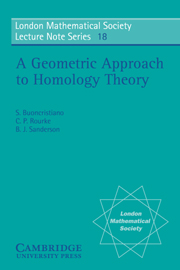Introduction
Published online by Cambridge University Press: 05 April 2013
Summary
The purpose of these notes is to give a geometrical treatment of generalised homology and cohomology theories. The central idea is that of a ‘mock bundle’, which is the geometric cocycle of a general cobordism theory, and the main new result is that any homology theory is a generalised bordism theory. Thus every theory has both cycles and cocycles; the cycles are manifolds, with a pattern of singularities depending on the theory, and the cocycles are mock bundles with the same ‘manifolds’ as fibres.
The geometric treatment, which we give in detail for the case of pl bordism and cobordism, has many good features. Mock bundles are easy to set up and to see as a cohomology theory. Duality theorems are transparent (the Poincaré duality map is the identity on representatives). Thorn isomorphism and the cohomology transfer are obvious geometrically while cup product is just ‘Whitney sum’ on the bundle level and cap product is the induced bundle glued up. Transversality is built into the theory – the geometric interpretations of cup and cap products are extensions of those familiar in classical homology. Coefficients have a beautiful geometrical interpretation and the universal coefficient sequence is absorbed into the more general ‘killing’ exact sequence. Equivariant cohomology is easy to set up and operations are defined in a general setting. Finally there is the new concept of a generalised cohomology with a sheaf of coefficients (which unfortunately does not have all the nicest properties). The material is organised as follows.
- Type
- Chapter
- Information
- A Geometric Approach to Homology Theory , pp. 1 - 3Publisher: Cambridge University PressPrint publication year: 1976



